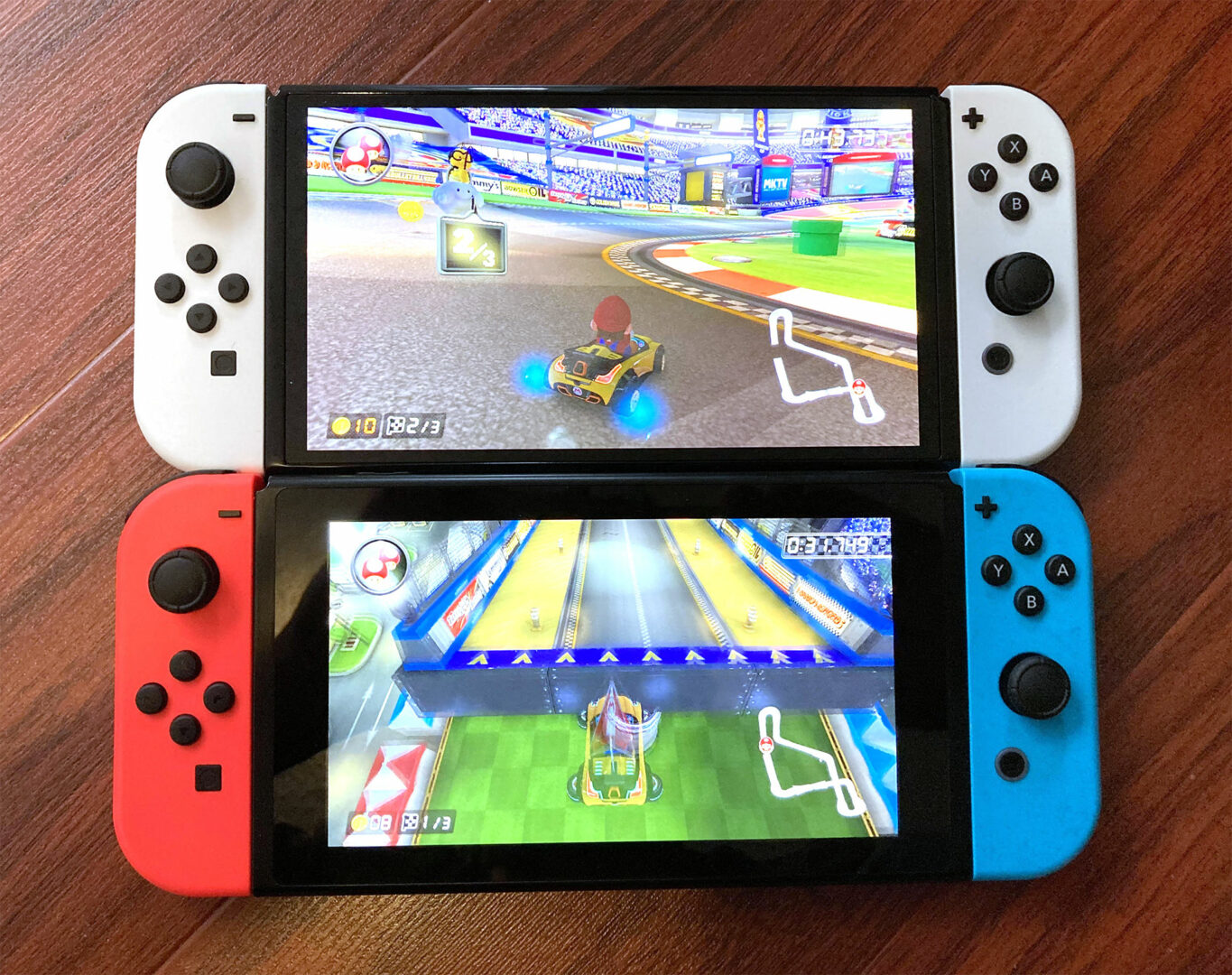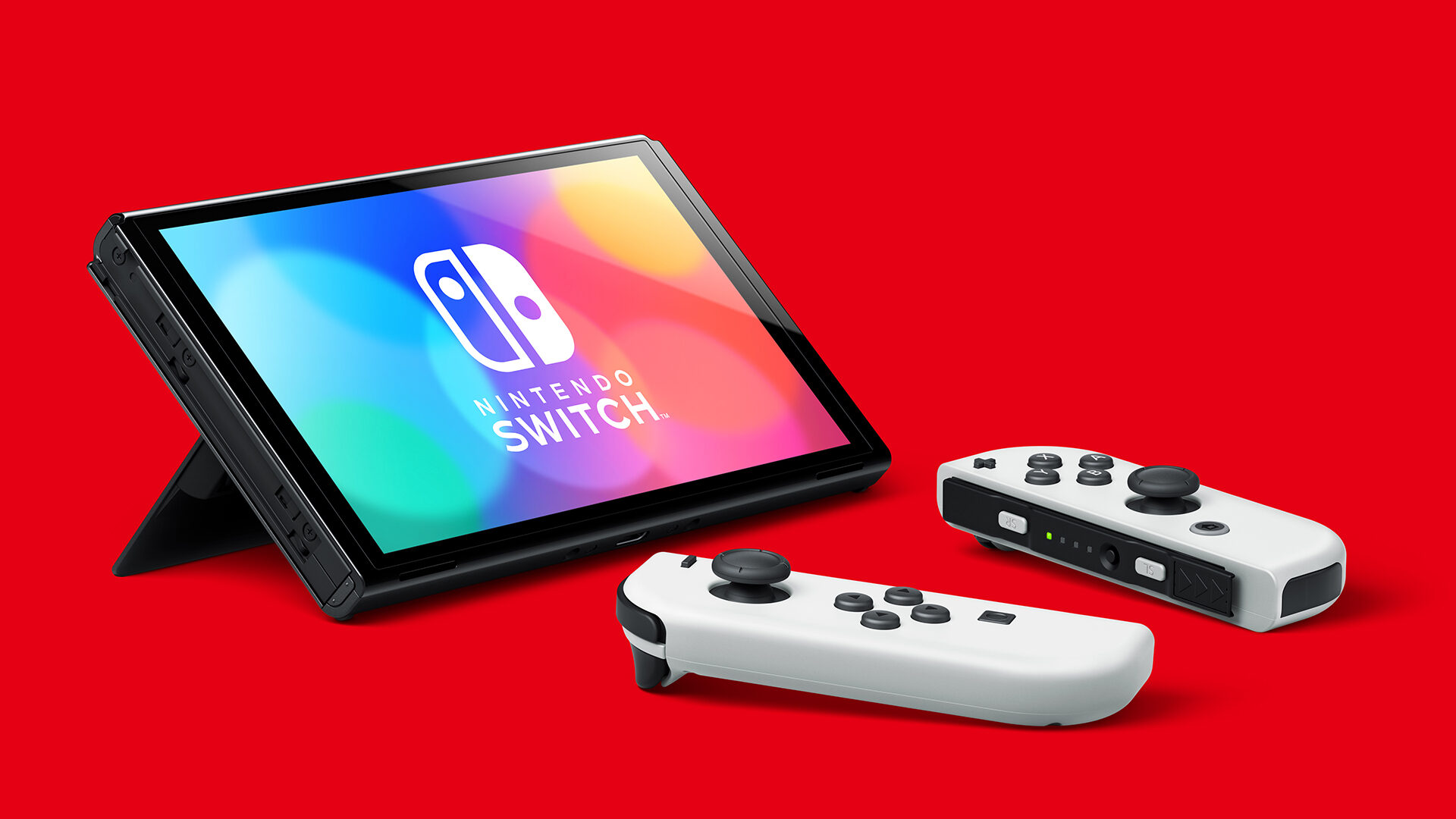I’m not a Nintendo fanboy per se, but I am a Switch fanboy. In terms of both form and function, the Switch is my favorite console—nay, my favorite material possession—maybe ever. At the very least, it’s the first console to rival the original Game Boy, PlayStation 2 and Xbox 360 as the top contenders for my gaming heart. The Switch is versatile, it’s got an iconic look, and it’s home to some of my favorite games over the last four years.
Because one of the features of the Switch that I love the most is that it’s both a handheld and a home console, I never had an interest in its second iteration, the Switch Lite. For players who only needed a handheld version at a discounted rate, it made perfect sense. But the Switch was the first purchase I made after cashing my first paycheck as a games writer, and I wasn’t in the market for a second Switch.
But now the Nintendo Switch – OLED Model (herein referred to as the Switch OLED) has hit stores, and it offers something slightly different. It’s got everything I loved about the original Switch, except it’s got a bigger and better screen, a dock with slightly more utility, double the internal storage, and vastly improved kickstand.
I don’t exactly know how to approach this review. It’s unfair of me to say whether you should purchase the Switch OLED, because I didn’t need to make that decision myself as Nintendo sent me a review unit. I can’t say whether I would have purchased a Switch OLED if that money was coming out of my own pocket because I didn’t (and don’t) have to even consider that possibility. Sure, I can make an assessment of the hardware, but it’s really as simple as saying that the Switch OLED is objectively better than the original model in every way.
The main highlight of the Switch OLED is obviously its screen. The OLED screen boasts a full diagonal inch on the original Switch’s LCD screen. Then there’s the difference between LCD and OLED. Whereas LCD (liquid crystal display) uses backlighting to pump colors and light into your eyeballs, OLED (organic light-emitting diode) does not require backlighting. The main difference between the two is that OLED can achieve more vibrant colors and much darker, purer blacks. That’s because OLED doesn’t have backlighting to create “light bleed” where the light from brighter parts of the screen bleeds into the darker parts, unlike LCD—which is, frankly, comparatively ancient technology at this point.

It’s hard to show how much of a difference the OLED screen truly makes when gaming on it, especially in a still frame taken on a smartphone, but the impact is startling in person and in motion. The picture that the Switch OLED pumps out is vibrant and full of more natural contrast. Even more impactful than the quality of the picture, however, is the size of the screen. While an inch might not seem like a lot, having the screen practically span the entire width between your mitts when playing in handheld mode is just easier on the eyes, especially for an old-timer like myself. (I’m 35, by the way—decrepit in gamer years.)
Still, it’s slightly disappointing that the only difference between the original Switch’s screen and the Switch OLED is the material that the displays use to emit light. Both displays still utilize 720p resolution and a 60Hz refresh rate. That means that, while the brightness and size of the OLED are clearly superior to the aged LCD of the original model, you’re still going to get those noticeable jagged edges on certain games when playing in handheld mode. I don’t care what others have said about how 720p is just fine for handheld gaming and that a 209 PPI pixel density is good enough; the jaggies are still pretty prominent on certain titles like The Legend of Zelda: Breath of the Wild. Of course, there are reasons for a 720p display over a 1080p display, especially when it comes to battery life. I’m just saying that the 720p resolution (when Switch games even manage to hit that benchmark) still shows its age—only on a brighter, bigger, and easier to look screen.
But the screen isn’t the only improvement that the Switch OLED boasts over the OG Switch in handheld mode. The audio that the Switch OLED’s speakers pump out is loud and crisp, and it genuinely adds so much more enjoyment and immersion to the handheld experience compared to the audio coming from the base Switch, which always sounded muted and underwhelming. Seeing as how I tend to play handheld mode if I’m in public and I’m not a complete piece of human garbage, I almost always use headphones or otherwise mute my console. But if I’m hanging out at home, reclining in bed or on the couch with a Switch and I can take advantage of the speakers, the improvements to the audio are notable.
That being said, the headphone jack is still on the top of the console. Most people probably won’t care, but I’m a weirdo and like my headphone jack on the bottom of my device. It’s not such a big deal now that the Switch supports Bluetooth devices, but I still like using my wired headphones sometimes and hate having a wire hanging down from the top of a console. It’s a very small and specific complaint, but it’s a complaint nonetheless.
The other major improvement to the Switch’s hardware in the OLED model is its kickstand. Personally, I’m just happy to be able to play in tabletop mode again, considering my original Switch’s flimsy kickstand snapped off in some random airport without me even realizing it years ago, and I haven’t played in tabletop mode since. What’s great about the new kickstand is that not only is it much beefier and more secure than the original Switch’s kickstand, but it’s also adjustable. In other words, you can set different viewing angles for the Switch OLED in tabletop mode depending on your seating situation, and it’s a massive quality-of-life improvement. I would guess that tabletop mode is probably the least popular way for people to use their Switch, but the Switch OLED’s kickstand might just change that—it’s that much better.
The only place where the Switch OLED slightly disappoints as an upgrade is in its internal storage. Its 64 GB is double that of the original Switch’s pitiful 32 GB, but it’s still far too easy to run out of space and have to rely on an additional microSD. Buying extra storage is admittedly much cheaper to do for the Switch than it is for an Xbox Series X or PlayStation 5, but I can’t help but be disappointed that Nintendo didn’t make more of an effort on that front.
Most of the comparisons between the Switch OLED and the original Switch stop there, since the biggest improvements are to the Switch itself. Of course, the Switch OLED’s dock is slightly different. Where the USB connection on the back of the dock used to be is now an ethernet port. It’s nice to be able to play Smash Bros. Ultimate or Splatoon 2 with a hardwired internet connection without having to purchase an adapter, but it’s frankly shameful that this feature wasn’t included in the original dock. There are still two USB ports on the side of the dock that comes with the Switch OLED, but it also means you’re down a USB port. Still, the tradeoff seems worth it to me, and I’m much more likely to play online multiplayer now than I was previously, despite Nintendo Switch Online’s communication features still being as rudimentary as they are.

Being able to forego wireless with the Switch OLED is great for another reason, albeit one that deals with yet another of Nintendo’s deficiencies: transferring your saves and game sharing. Mollie covered this process pretty extensively in her review of the Switch Lite, so I won’t repeat every word of that, but her complaints for it still stand. If you’re getting the Switch OLED as a second Switch and want to transfer all of your save data over, you will still have to manually select which save data you want to transfer, even if you have access to the cloud through Switch Online (which you of course have to pay for). Connecting to the internet via ethernet means that the saves transfer pretty much instantly, but it’s still annoying.
If you don’t have Switch Online, then you will have to transfer between both consoles anyway, and this process can be painfully slow, especially if you have a lot of data to transfer over. And you still can’t boot up digital games on a secondary Switch without an internet connection, which means that buying a Switch OLED and giving your old Switch to your kids or your partner will require at least one of those Switch’s to be connected to the internet at all times. It’s reason enough to start buying physical copies again for two-Switch homes. At least the Switch and the Switch OLED are the same dimensions, so you won’t have to buy a new carrying case.
While I might have complaints for how Nintendo treats its user base, I don’t really have many complaints for the Switch OLED itself. I know I said I wasn’t going to do this, but: If you don’t already own a Switch, it seems worth it to me to pony up an extra $50 for a vastly better handheld experience and an ethernet port. However, if you already own a Switch, I can’t say for certain whether it’s worth buying another one just for the OLED screen and a better kickstand. You’re going to have to make that call for yourself.
|
★★★★☆
The Nintendo Switch – OLED Model might not be the “pro” upgrade that fans were hoping for, but it’s still a great console made even better, bigger, and brighter. Just expect a few headaches when transferring your saves, and maybe consider buying physical copies of your games from now on if this is your second Switch. |
Publisher Nintendo Release Date 10.08.21 |
| Nintendo Switch – OLED Model is available on . Primary version played was for . Product was provided by Nintendo for the benefit of this coverage. EGM reviews on a scale of one to five stars. | |

Michael Goroff has written and edited for EGM since 2017. You can follow him on Twitter @gogogoroff.